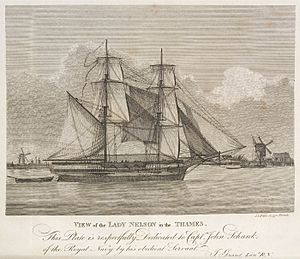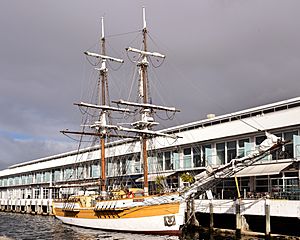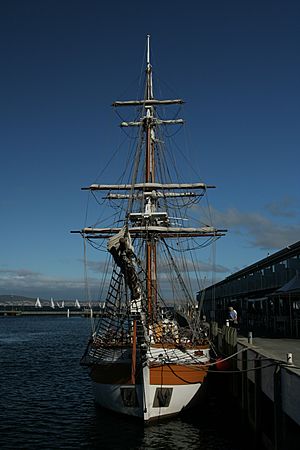HMS Lady Nelson (1798) facts for kids
class="infobox " style="float: right; clear: right; width: 315px; border-spacing: 2px; text-align: left; font-size: 90%;"
| colspan="2" style="text-align: center; font-size: 90%; line-height: 1.5em;" |
|} His Majesty's Armed Survey Vessel Lady Nelson was a special ship built in 1799. Its main job was to explore and map the coast of Australia. Back then, large parts of Australia were still unknown to Europeans. Britain wanted to claim these areas before other European countries did.
The Lady Nelson left Portsmouth in England on March 18, 1800. It arrived in Sydney on December 16, 1800. This ship was the first to reach the east coast of Australia by sailing through Bass Strait. Before this, all ships had to go around the southern tip of Tasmania.
Soon after arriving in Sydney, the Lady Nelson began its important survey work. It helped discover Port Phillip in Victoria. It also helped set up new settlements. These included places on the River Derwent and at Port Dalrymple in Tasmania. It also helped establish settlements at Newcastle and Port Macquarie in New South Wales. Later, it explored Melville Island off Australia's north coast.
Contents
- Building the Lady Nelson
- Voyage to Australia
- First Trip Through Bass Strait
- Exploring Bass Strait with Murray
- Helping the Investigator
- Settling Tasmania
- Moving the Port Phillip Settlement
- Settling Port Dalrymple
- Capture of Extremeña
- Later Service and Loss
- Replica Vessels
| History | |
|---|---|
| Name | Lady Nelson |
| Operator | The Royal Navy |
| Builder | John Dudman |
| Launched | 1798 |
| Commissioned | 1799 |
| Fate | Lost 1825 |
| General characteristics | |
| Type | Armed Survey Vessel |
| Tons burthen | 60 (bm) |
| Length | 52 ft 6 in (16.00 m) |
| Beam | 17 ft 6 in (5.33 m) |
| Draught | 12 ft (3.7 m) (with keels lowered) |
| Propulsion | Sail |
| Sail plan | Brig |
| Complement | 17 |
| Armament | Six brass carriage guns (3 and 4 pounder) |
Building the Lady Nelson
In the late 1790s, the British colony in New South Wales needed more ships. The ships they had were old and not safe for long voyages. So, in 1799, the Transport Board ordered a new ship. It was a 60-ton cutter named Lady Nelson.
The ship's design was special. It was based on a ship called Trial, which had three sliding keels. These keels could be raised or lowered. This was very useful for a survey ship that needed to sail in shallow waters. When the Lady Nelson left England, its deep part (draught) was 12 feet. But with the keels raised, it could sail in water as shallow as six feet!
Philip Gidley King, who would later become Governor of New South Wales, saw the Lady Nelson being built. He suggested changing it from a cutter to a brig. A brig is a type of sailing ship with two masts. This change would make it easier for sailors to manage.
The Lady Nelson was built by John Dudman in Deptford, England. Its first commander was Lieutenant James Grant. His orders were to explore and map the unknown parts of New Holland (Australia).
Voyage to Australia
The Lady Nelson was packed with enough food for nine months and water for six months. It did not have a chronometer, which is a very accurate clock used for navigation.
The ship left Deptford on January 13, 1800. It sailed to Portsmouth to join a group of ships (a convoy). This convoy would protect it from French and Spanish ships. While in Portsmouth, the Lady Nelson had its guns increased from two to six.
Many people thought the Lady Nelson was too small for such a long journey. This made it hard for Lieutenant Grant to keep his crew. Some sailors even ran away. When the ship finally sailed on March 18, it had only three officers and ten crew members.
The Lady Nelson soon found it could not keep up with the larger ships in the convoy. So, it continued its journey alone. On April 13, it stopped at Praia in the Cape Verde Islands. Here, they found that part of a keel had broken off. They fixed it, even though they didn't have a carpenter on board. Grant also took on two young men from the island to help with the crew.
The ship reached Table Bay in South Africa on June 8, 1800. Here, they found that both the main and back keels were badly damaged. They were replaced with new ones. They also discovered that the ship's leaks were because the seams were filled with putty instead of proper sealing material!
While at the Cape, Grant received new orders. He was told to sail through the newly discovered Bass Strait on his way to Sydney. This would shorten his journey and allow him to map the strait more closely.
The Lady Nelson left the Cape on October 7, 1800. Grant also took on a carpenter and a Danish sailor named Jorgen Jorgenson.
First Trip Through Bass Strait
The Lady Nelson first saw the Australian mainland on December 3, 1800. This was near the border of what is now South Australia and Victoria. Grant named several places along the coast. He named one mountain after Captain Schanck (now Mount Schank). He named another Gambier's Mountain. He also named Cape Banks and Cape Northumberland.
On December 7, the Lady Nelson entered Bass Strait. Grant named Cape Otway and Cape Patton. He also named a large bay Portland Bay. The next day, the ship sailed across a huge bay, which Grant called Governor King's Bay. This bay is now known as Port Phillip.
Since the coast between Wilsons Promontory and Sydney had already been mapped, Grant sailed straight to Sydney. The Lady Nelson arrived in Sydney Cove on December 16, 1800. The journey from the Cape of Good Hope had taken 71 days.
When the ship arrived, the crew's contracts ended. Governor King had to find a new commander and crew. He offered command to James Grant, who accepted. John Murray became the First Mate. Most of the original crew did not want to stay because the pay was lower. So, King had to recruit some well-behaved convicts to serve on the ship.
Exploring Bass Strait with Murray
Governor King ordered the Lady Nelson to return to Bass Strait. Its mission was to map the areas that had not been explored before.
The Lady Nelson left Sydney on November 12, 1801. It first explored the Furneaux Group of islands near Tasmania. Then, it sailed to the Kent Group, where it mapped a channel now called Murray Pass.
From there, the ship headed northwest and anchored in Western Port on December 7. Bad weather kept them there for several days.
On January 4, 1802, the Lady Nelson left Western Port. The next day, they saw an opening in the land that looked like a large harbor. This was the entrance to the future Port Phillip. Murray noted it was "a sheet of smooth water... and is apparently a fine harbour of large extent."
On February 17, while anchored in Port Phillip, Murray's crew met local Aboriginal people. They traded and shared food. However, another group of Aboriginal people later attacked the crew. The crew fired their guns, and Murray ordered cannons to be fired from the ship as the Aboriginal people ran away.
The Lady Nelson could not enter the new harbor right away due to strong winds. It sailed west but was forced back by a storm. It then explored King Island before returning to Western Port on January 31, 1802.
Murray sent a small boat to explore the entrance to the new harbor. The boat returned on February 4, reporting a good channel into the large harbor. This meant the Lady Nelson's boat was the first European vessel to enter Port Phillip.
On February 14, 1802, the Lady Nelson finally sailed into the new harbor. Murray named it Port King. However, Governor King later renamed it Port Phillip, after the first Governor, Captain Arthur Phillip.
The Lady Nelson stayed in Port Phillip for 25 days. On March 8, 1802, Murray officially claimed the port for Great Britain. He raised the British flag and fired guns. The city of Melbourne would later grow on the north shore of this port. The Lady Nelson returned to Sydney on March 25, 1802.
Helping the Investigator
In May 1802, the Lady Nelson was ordered to help HMS Investigator. The Investigator was on a big journey to explore the coast of Australia. The Lady Nelson would act as a smaller support ship.
The two ships left Sydney on July 22, 1802, and sailed north. The Lady Nelson often struggled to keep up with the larger Investigator. But it was very useful for exploring shallow areas where the Investigator could not go. Sometimes, Captain Matthew Flinders, commander of the Investigator, would even switch to the Lady Nelson to do his mapping work.
The Lady Nelson helped Flinders explore places like Keppel Bay, Shoalwater Bay, and Broad Sound. It was also there when Flinders discovered and named Port Curtis and Port Bowen (now Port Clinton).
However, the Lady Nelson often ran aground, damaging its sliding keels. This made it even harder to keep up. It also lost anchors. On October 17, Flinders decided to send the Lady Nelson back to Sydney. It was sailing too slowly and was becoming a danger rather than a help.
The Lady Nelson headed south alone. It lost its last good anchor and had to make a temporary one from two cannons! It finally arrived back in Sydney on November 22, 1802. This marked the end of the Lady Nelson's major exploration voyages.
After this, the Lady Nelson made a trip to Norfolk Island. Its next commander was George Curtoys.
Settling Tasmania
The Lady Nelson was chosen to help set up the first British settlement in Tasmania. This was because Governor King was worried that the French might try to settle there first.
The chosen spot was Risdon Cove, on the River Derwent, where Hobart now stands. Lieutenant John Bowen was in charge of the new settlement. The Lady Nelson and another ship, Porpoise, were to carry the settlers, supplies, and food.
The Lady Nelson left Sydney on June 11, 1803. But it faced very bad weather. Its boat was lost, and part of its main keel broke off. It had to return to Sydney for repairs. It tried again on August 21 but had to turn back because its mast was damaged.
Finally, the Lady Nelson set off again on August 29, 1803, with another ship called Albion. This time, the journey was smoother. The Lady Nelson arrived at Risdon Cove on September 9, 1803. They spent several days unloading supplies and helping the settlers get established.
Moving the Port Phillip Settlement
In October 1803, two ships arrived in Port Phillip from England. They were there to start a new settlement. But the plan didn't work out. The settlers decided to move to Tasmania instead.
The Lady Nelson was one of four ships used to move the people. George Curtoys, the commander, became ill and returned to England. James Symons took over command of the Lady Nelson.
The Lady Nelson left Sydney on November 28, 1803. It faced rough weather in Bass Strait and had to take shelter in the Kent Group of islands. It took many attempts to reach Port Phillip.
The Lady Nelson finally arrived at Port Phillip on January 21, 1804. It helped move the settlers to the Derwent River in Tasmania. The Lady Nelson returned to Sydney on March 14, 1804.
For the next few months, the Lady Nelson carried people and supplies. It helped take people to a new settlement at Kingstown, which was later renamed Newcastle.
Settling Port Dalrymple
In May 1804, Governor King received orders to close the settlement at Norfolk Island. The settlers there were to be moved to a new settlement at Port Dalrymple in Tasmania.
Lieutenant Colonel Paterson was put in charge of this new settlement. The Lady Nelson joined a group of ships carrying the settlers. They left Sydney on October 15, 1804.
The Lady Nelson faced terrible storms during this voyage. Its boat, compasses, and part of its keel were lost. It had to stop for repairs. The bad weather continued, damaging its sails.
Finally, the Lady Nelson reached Port Dalrymple on November 21, 1804. After unloading its cargo, the ship helped map the harbor and set up markers to guide other ships safely. The Lady Nelson was the last ship of the group to leave, departing on January 11, 1805. It arrived back in Sydney on January 23, 1805.
Capture of Extremeña
In April 1805, Governor King heard that a Spanish ship was in Jervis Bay, south of Sydney. King sent the Lady Nelson, commanded by Acting-Lieutenant Symons, to find it.
The Spanish ship was called Extremeña. When it saw the Lady Nelson, it tried to escape. But Symons fired a shot across its front, stopped it, and brought it back to Sydney.
Later Service and Loss
For many years, the Lady Nelson continued to carry passengers and supplies. It sailed between Sydney and the other settlements in New South Wales and Tasmania.
- In 1806, it sailed to New Zealand to take a Maori Chief named Tip-pa-he back home.
- In 1811, Governor Lachlan Macquarie sailed on the Lady Nelson to inspect the settlements in Tasmania.
- The ship also helped move the last settlers from Norfolk Island to Port Dalrymple in 1813.
In 1819, the Lady Nelson helped survey the entrance to Port Macquarie. A new settlement was planned there. In March 1821, the Lady Nelson helped carry convicts and troops to Port Macquarie. While entering the river, it hit a hidden rock but got off. Later, when leaving, it ran aground again, losing its rudder and stern-post. It took 13 months to repair!
In 1824, the Lady Nelson was part of an expedition to set up a new settlement on the north-west coast of Australia, near Melville Island. The ship stayed there as a guard and supply vessel.
In December 1824, the Lady Nelson was sent to Timor to get fresh food like buffaloes and goats. Many of the animals died before it returned. It went again in February 1825 to get more livestock.
Sadly, the Lady Nelson never returned from this last trip. Reports said it was attacked by Malay pirates near Babar Island. All the crew were killed, except for the Captain. The ship's hull was seen later with its name still painted on the back.
Replica Vessels
Mount Gambier Replica (1986)

In 1986, a full-size, non-sailing replica of the Lady Nelson was built in Mount Gambier, South Australia. It was part of celebrations for the 150th anniversary of South Australia.
In 2011, the replica was found to be badly rotted. It was rebuilt with a fiberglass hull and steel masts. The rebuilt replica is now a tourist attraction at the Mount Gambier Visitor Centre.
Tasmanian Sail Training Association Replica (1988)
The Tasmanian Sail Training Association built another replica of the Lady Nelson. This was for Australia's 200th anniversary in 1988. It cost over $700,000 and was built by Ray Kemp near Hobart, Tasmania. He used local timbers like blue gum and celery-top pine.
This replica was launched on November 29, 1987. It went on its first cruise in March 1989.
This replica has sailed on many voyages:
- In January 1998, it went to Sydney for a Tall Ships Race.
- In late 2000, it visited Portland, Victoria, to remember the original Lady Nelson's journey through Bass Strait.
- In March 2001, it re-enacted the original ship's first entry into Western Port.
- On February 14, 2002, it sailed into Port Phillip Bay, exactly 200 years after the original ship.
- In 2003, it visited Sorrento in Port Phillip Bay to remember the first settlers arriving there.




